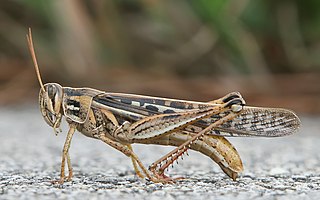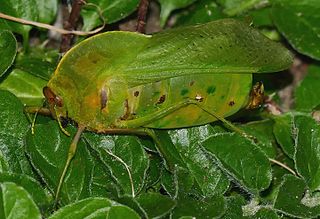
Insects in the family Tettigoniidae are commonly called katydids or bush crickets. They have previously been known as "long-horned grasshoppers". More than 8,000 species are known. Part of the suborder Ensifera, the Tettigoniidae are the only extant (living) family in the superfamily Tettigonioidea.

Grasshoppers are a group of insects belonging to the suborder Caelifera. They are amongst what are possibly the most ancient living groups of chewing herbivorous insects, dating back to the early Triassic around 250 million years ago.
The Zayante band-winged grasshopper is a species of insect in the family Acrididae. It is endemic to a small portion of the Santa Cruz Mountains in California.

Tettigonia viridissima, the great green bush-cricket, is a large species of bush-cricket belonging to the subfamily Tettigoniinae.

Crickets are orthopteran insects which are related to bush crickets, and, more distantly, to grasshoppers. In older literature, such as Imms, "crickets" were placed at the family level, but contemporary authorities including Otte now place them in the superfamily Grylloidea. The word has been used in combination to describe more distantly related taxa in the suborder Ensifera, such as king crickets and mole crickets.

The band-winged meadowhawk is a dragonfly of the genus Sympetrum belonging to the family Libellulidae.

Bembecia ichneumoniformis, the six-belted clearwing, is a moth of the family Sesiidae.

The blue-winged grasshopper, Oedipoda caerulescens, is a grasshopper in the genus Oedipoda.

Anacridium aegyptium, the Egyptian grasshopper or Egyptian locust, is a species of insect belonging to the subfamily Cyrtacanthacridinae.

Miramella alpina, commonly known as the green mountain grasshopper, is a species of short-horned grasshopper in the family Acrididae.

Oedipoda germanica, sometimes known as the "red-winged grasshopper", is a species of short-horned grasshoppers belonging to the family Acrididae subfamily Oedipodinae.

Spharagemon collare, the mottled sand grasshopper, is found in sandy-soiled, grassy areas of northern United States and southern Canada. They are known to be a minor pest of wheat crops; however, populations are rarely large enough to cause appreciable damage.

Taeniopoda eques, the western horse lubber grasshopper, is a relatively large grasshopper species of the family Romaleidae found in arid and semi-arid parts of southwestern United States to central and southwestern Mexico. Most populations are identifiable by their shiny black bodies with contrasting yellow markings, but some adults are mostly yellowish, orangish or greenish. The species is unique in using its black coloration to thermoregulate and in being chemically defended. The aposematic coloration warns vertebrate predators of its unpalatability and allows the grasshopper to roost conspicuously upon shrubs.

Conocephalus fuscus, the long-winged conehead, is a member of the family Tettigoniidae, the bush-crickets and is distributed through much of Europe and temperate Asia. This bush-cricket is native to the British Isles where it may confused with the short-winged conehead. These two species are phenotypically similar; however, the distinguishing factor between the two is the fully developed set of wings the long-winged conehead possesses that allows for flight. In the short-winged coneheads the hind wings are shorter than the abdomen, causing the wings to be vestigial and the species is incapable of flight. For this reason it is hard to discriminate between the two species during the early stages of their life cycle before the wings have fully developed. The colouration of the conehead is typically a grass green with a distinctive brown stripe down its back, though there are some brown phenotypes.

The Pneumoridae are a family of nocturnal short-horned grasshoppers in the order Orthoptera, commonly known as the bladder grasshoppers and the sole representative of the superfamily Pneumoroidea. Their centre of diversity is in southern Africa, but one species occurs as far north as South Sudan. Most adult males acquire an inflated abdomen, a specialization for amplified sound production, which is likely its primary function. Most genera display striking sexual dimorphism, and several species exhibit a dual male phenotype.

Arphia granulata is a species of grasshopper in the subfamily Oedipodinae, in the family Acrididae. The species is known generally as the "southern yellow-winged grasshopper". It is found in North America.

Arphia is a genus of band-winged grasshoppers in the family Acrididae. There are at least 11 described species in the genus Arphia.

Arphia behrensi, the California sulphur-winged grasshopper, is a species of band-winged grasshopper in the family Acrididae. It is found in California along the Sierra Nevada, the San Francisco Bay Area, and north of the Bay Area.

Trimerotropis huroniana, known generally as the lake Huron locust or great lakes grasshopper, is a species of band-winged grasshopper in the family Acrididae. It is found in Wisconsin and Michigan in the United States, and Ontario in Canada.

Caedicia simplex is a species of bush cricket or katydid, native to New Zealand and Australia. A common name is the "common garden katydid".


















